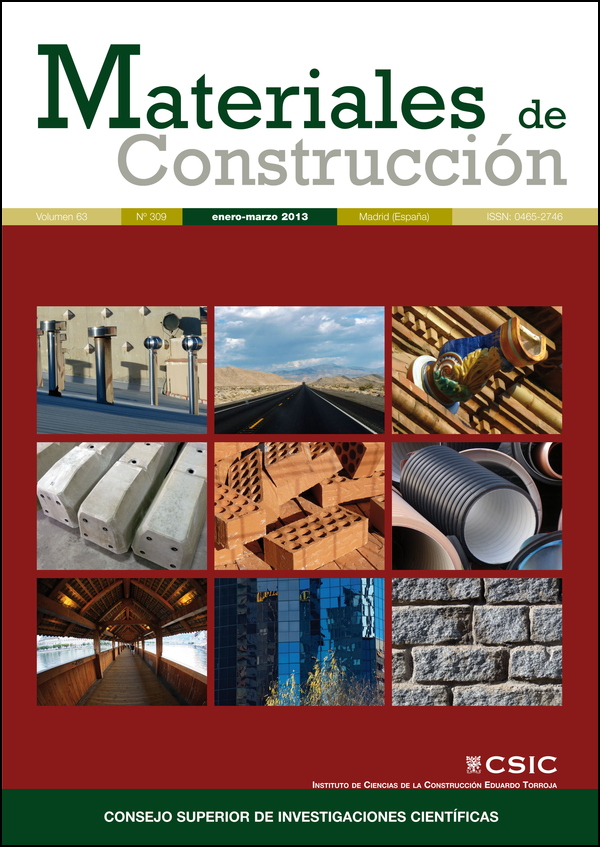Young modulus variation of a brickwork masonry element submitted to high temperatures
DOI:
https://doi.org/10.3989/mc.2012.02311Keywords:
brickwork masonry, high temperatures, Young´s modulus, thermo mechanical behaviourAbstract
In order to understand the thermal behavior of the masonry elements submitted to high temperatures we need to know the variation of their thermal properties with regard to the temperature. Submitted to high temperatures clay brick masonry presents thermomechanical effects (as the variation of Young's modulus, the thermal expansion of the unit and the mortar, spalling, losses of resistance …) as well as variation of the properties of the material as result of its degradation. In this article the variation of the module of elasticity of the unit and the mortar is described with regard to high temperatures according to the state of the knowledge. In this article is also exposed the results obtained from the experimental program carried out on elements of clay brick masonry submitted to high temperatures in order to observe the variation of Young's module related to temperature.
Downloads
References
(1) S. J. Lawrence, N. Gnanakrishnan: "The Fire Resistance of Masonry Walls. An Overview". First National Structural Engineering Conference. Melbourne, 26-28 August (1987).
(2) J. López, S. Oller, E. Oñate: "Cálculo del comportamiento de la mampostería mediante elementos finitos". Monografía CIMNE M46 (1998).
(3) T. Anderberg, S. Thelandersson: "Stress and Deformation characteristics of concrete al high temperatures. Experimental investigation and material behaviour model". Institute of Technology, Lund, Sweden. Bulletin 54 (1976).
(4) N. Gnanakrishnan, R. Lawther: "Some aspects of the fire performance of single leaf masonry construction". International Symposium on Fire Engineering for Building Structures and Safety. Melbourne. National Conference Publication, Vol.89/16 (1989), pp. 93-99.
(5) C.R. Cruz: "Elastic Properties of concrete at high temperatures". J. PCA Research and Development Laboratories, Vol. 8, nº1 (1966).
(6) M.S. Abrams: "Behaviour of inorganics materials in fire". Symposium on design of buildings for fire safety. ASTM Special Technical Publications, nº 685 (1979).
(7) J. Lee, K. Choi, K. Hong: "Color and material property changes in concrete exposed to high temperatures". Journal of Asian Architecture and Building Engineering. Vol 8. nº1 (2009), pp. 175-182. http://dx.doi.org/10.3130/jaabe.8.175">http://dx.doi.org/10.3130/jaabe.8.175
(8) T. Nguyen et Al: "The behaviour of masonry walls subjected to fire: Modelling and parametrical studies in the case of hollow burnt-clay bricks". Fire Safety Journal nº44 (2009), pp.629-641 http://dx.doi.org/10.1016/j.firesaf.2008.12.006">http://dx.doi.org/10.1016/j.firesaf.2008.12.006
(9) IETcc (CSIC). "Estudio de las propiedades térmicas y mecánicas en elementos de fábrica a través de ensayos en horno". Informe interno. Investigación Prenormativa. Proyecto Código Técnico de la Edificación (2005).
(10) C. Castillo. " Effect of transient high temperatures on high strength concrete". Tesis Doctoral (1987). Rice University. Houston (Texas).
(11) Z.P. Bazant, M.F. Kaplan. "Concrete at High Temperatures: Material properties and mathematical models".Concrete design and Construction Series. p. 424, Longman, 1996.
(12) UNE EN 771-1:2003. Especificaciones de piezas para fábrica de albañilería. Parte 1: Piezas de arcilla cocida. AENOR.
(13) UNE EN 998-2:2004. Especificaciones de los morteros para albañilería. Parte 2: Morteros para albañilería. AENOR.
(14) UNE EN 1015-2: 2000. Métodos de ensayo de los morteros para albañilería. Parte 2: Toma de muestra total de morteros y preparación de los morteros de ensayo. AENOR.
(15) UNE EN 1996-1-2:2005. Proyecto de estructuras de fábrica. Parte 1-2: Reglas generales. Proyecto estructural en caso de incendio. AENOR.
(16) CTE DB SE-F, 2006. Documento Básico "Seguridad Estructural para elementos de fábrica". Código Técnico de la Edificación.
Downloads
Published
How to Cite
Issue
Section
License
Copyright (c) 2013 Consejo Superior de Investigaciones Científicas (CSIC)

This work is licensed under a Creative Commons Attribution 4.0 International License.
© CSIC. Manuscripts published in both the print and online versions of this journal are the property of the Consejo Superior de Investigaciones Científicas, and quoting this source is a requirement for any partial or full reproduction.
All contents of this electronic edition, except where otherwise noted, are distributed under a Creative Commons Attribution 4.0 International (CC BY 4.0) licence. You may read the basic information and the legal text of the licence. The indication of the CC BY 4.0 licence must be expressly stated in this way when necessary.
Self-archiving in repositories, personal webpages or similar, of any version other than the final version of the work produced by the publisher, is not allowed.
















